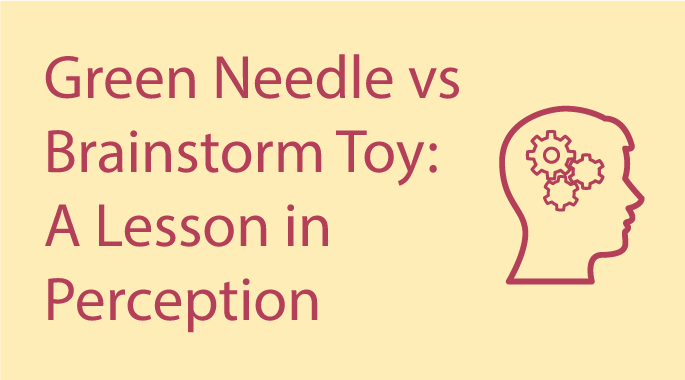Table of Contents
Introduction: Green Needle vs Brainstorm Toy
Have you ever come across a viral video or audio clip that left you baffled, questioning the way your brain processes information? The Green Needle vs Brainstorm toy is a prime example of how our expectations and perceptions can influence our sensory experiences. This intriguing phenomenon has taken social media by storm, leaving people around the world scratching their heads. In this blog post, we’ll delve into the mystery of the “Green Needle Brainstorm” toy, exploring the psychology behind it and what it teaches us about our perception.

The Viral Sensation: Green Needle vs Brainstorm
The tale begins with a deceptively ordinary children’s toy. Upon activation, it produces a sound that baffles listeners, with some hearing “brainstorm” and others hearing “green needle.” The intriguing twist? What you hear is contingent on your mental focus and expectations. When individuals concentrate on “brainstorm,” they report hearing one word, while a shift to “green needle” dramatically alters their perception.
The Psychology Behind It
This peculiar phenomenon taps into the fascinating realm of perception psychology. Our brains are wired to process sensory input in a way that aligns with our expectations. When we’re anticipating a particular word or sound, our brain might emphasize certain aspects of the audio signal to confirm our expectations. This leads to a perceptual bias where we hear what we’re primed to hear, often to the exclusion of alternative interpretations.
In the fascinating case of the “Green Needle vs Brainstorm” toy, our brains reveal a remarkable aspect of their cognitive prowess. They act as expert fillers of perceptual gaps to align with our expectations. This phenomenon illustrates the brain’s incredible ability to adapt and accommodate our beliefs and anticipations. When presented with an ambiguous auditory signal, such as the toy’s vocalization, our brains diligently work to decipher it. In doing so, they tend to emphasize certain aspects of the audio, reinforcing what we anticipate and steering our perception in that direction.
Consequently, this intriguing illusion has led to some intriguing conversations and debates. It’s not uncommon to find individuals who are absolutely convinced they hear “brainstorm,” while others, equally certain, insist they hear “green needle” when listening to the same recording. This stark disparity in perception, driven by the power of expectation, serves as a captivating testament to the malleability of human perception and the ways our minds can adapt to fit the narrative we have in mind. It’s a vivid reminder that what we perceive is not always a direct reflection of reality but a product of our complex cognitive processes and the influence of our conscious expectations.
The Power of Suggestion in Green Needle vs Brainstorm Toy
The phenomenon also underscores the incredible power of suggestion. If you go into the experience expecting to hear one word, your brain is more likely to interpret the audio accordingly. This is why videos of people switching between “green needle and brainstorm” by simply saying the word they want to hear have gone viral. It demonstrates how our conscious thoughts can steer our perception.
What ‘Green Needle vs Brainstorm Toy’ Teaches Us
The “Green Needle vs Brainstorm” toy teaches us a valuable lesson about the malleability of human perception. It reminds us that what we perceive is not always an accurate reflection of objective reality. Our expectations, mental focus, and suggestions from our environment can shape the way we interpret the world around us.
In our daily lives, this phenomenon underscores the importance of remaining open to multiple interpretations and being aware of the power of suggestion. It highlights the need for critical thinking and the recognition that our perception can be influenced by external factors.
Conclusion: Complexity of Human Perception
The Green Needle vs Brainstorm toy is not just a viral sensation; it’s a thought-provoking reminder of the complexities of human perception. The next time you encounter a puzzling phenomenon or a situation where people seem to hear different things, remember the influence of expectation, mental focus, and suggestion on what we perceive. It’s a testament to the intricacies of the human mind and the many mysteries still waiting to be uncovered in the world of psychology.
You can watch the video of the toy below, or you can click this link.